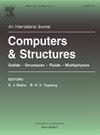A geometrically nonlinear finite element formulation for buckling analysis of shear deformable angle-ply composite beam-type structures
Abstract
This paper introduces an improved shear-deformable beam formulation for nonlinear buckling analysis of laminated composite beam-type structures with thin-walled cross-sections. Each wall of a cross-section is assumed to be a thin symmetric and balanced angle-ply laminate. The incremental equilibrium equations of a straight beam element are derived by applying the virtual work principle within the framework of updated Lagrangian formulation, Hooke’s law and the nonlinear displacement field of a thin-walled cross-section, which takes into account restrained warping and large rotation effects. Incremental stress resultants are calculated by the Timoshenko–Ehrenfest beam theory for bending and the modified Vlasov theories for torsion. Shear coupling problems occurring at non-symmetric thin-walled cross-sections and arising from the shear forces-warping torsion moment couplings are considered. As a result, new shear-correction factors for a cross-section composed of thin angle-ply laminates are derived. Force recovering is performed according to the conventional procedure based on the concept of semitangential rotations. The shear-locking occurrence is prevented by applying the Hermitian cubic interpolation functions for deflections and twist rotation, and the associated quadratic functions for slopes and warping. The effectiveness of the proposed geometrically nonlinear shear-deformable beam formulation is validated through the test problems.

 求助内容:
求助内容: 应助结果提醒方式:
应助结果提醒方式:


